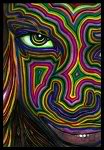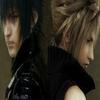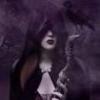Honor: 0 [ Give / Take ]
Celtic blessing~
Deep peace of the running wave to you,
Of water flowing, rising and falling,
Sometimes advancing, sometimes receding.
May the stream of your life flow unimpeded!
Deep peace of the running wave to you!
Deep peace of the flowing air to you,
Which fans your face on a sultry day,
The air which you breathe deeply, rhythmically,
Which imparts to you energy, consciousness, life.
Deep peace of the flowing air to you!
Deep peace of the quiet earth to you,
Who, herself unmoving, harbors the movements
And facilitates the life of the ten thousand creatures.
While resting contented, stable, tranquil.
Deep peace of the quiet earth to you!
Deep peace of the shining stars to you,
Which stay invisible till darkness falls
And discloses their pure and shining presence
Beaming down in compassion on our turning world.
Deep peace of the shining stars to you!
~~~
I am Celtic. The following is a big part of my heritage and my ancestry. I am of the Clan MacDonald. This is my clan badge. PER MARE PER TERRAS means over land and sea.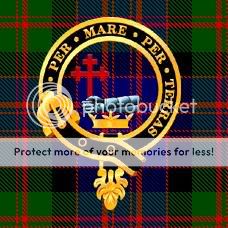 The largest of the Highland clans, the Gaelic first name "Domnuill" was anglicised to "Donald". The original Donald was a grandson of the mighty King Somerled who drove out the Vikings in the 12th century. Somerled's mother was Norse and his father was descended from the kings of Dalriada, according to clan history. The family was founded in Islay and extended their territory to the mainland. Donald's great-grandson, "Good" John of Islay, became known as Lord of the Isles and later holders of the title became powerful enough to challenge the king of Scotland. Many MacDonalds emigrated to North America and other parts of the world in the 18th and 19th century.
The largest of the Highland clans, the Gaelic first name "Domnuill" was anglicised to "Donald". The original Donald was a grandson of the mighty King Somerled who drove out the Vikings in the 12th century. Somerled's mother was Norse and his father was descended from the kings of Dalriada, according to clan history. The family was founded in Islay and extended their territory to the mainland. Donald's great-grandson, "Good" John of Islay, became known as Lord of the Isles and later holders of the title became powerful enough to challenge the king of Scotland. Many MacDonalds emigrated to North America and other parts of the world in the 18th and 19th century.
Scotland has a rich Celtic History going back over 2,000 years, at a time when superstition was rife and where unusual events were "explained" by stories and inventions which were then passed on by word of mouth. It is therefore not surprising that Scotland has an extensive heritage of myths and legends.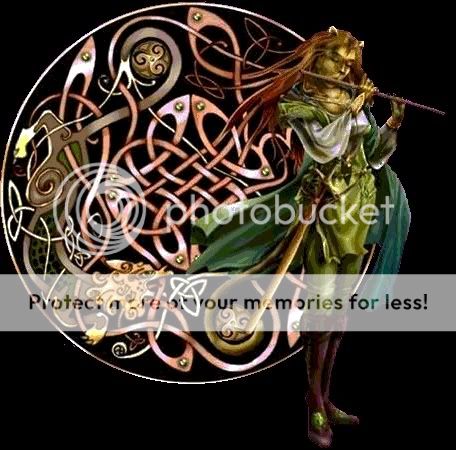
Manannan mac Lir explains the transition from the old Celtic religion to Christianity. One of the legends of Manannan includes an account of a prominent ancestor of Clan Donald who nearly lost his entire posterity when tempted with an apple. And just as recorded in the Biblical account our ancestor's taking the apple provides the Celtic explanation of how he acquired the knowledge & wisdom for which he was famous.
The kelpie is a supernatural water horse from Celtic folklore that is believed to haunt the rivers and lochs of Scotland and Ireland; the name may be from Scottish Gaelic cailpeach or colpach 'heifer, colt. The horse's appearance is strong, powerful, and breathtaking. Its skin is like that of a seal, smooth but is as cold as death when touched.
Water horses are known to transform into beautiful women to lure men into their traps. The water horse creates illusions to keep itself hidden, keeping only its eye above water to scout the surface, much like the illusion of a fish's pupil. It is wise to keep away from them.
Legend tells us that a Scottish queen was given a ring by her husband. But she gave it to a handsome soldier and the king found out. He came across the soldier asleep by a river bank, took the ring, threw it in the water and challenged his wife to produce the ring. St Mungo, who was to become the patron saint of Glasgow, miraculously returned the ring by catching the right salmon and finding it in its stomach.
There is a long tradition of claims to be able to foretell the future and having the ability to have Second Sight. The most famous of these, was Coinneach Odhar, better known as the Brahan Seer, some of whose visions for the future are said to have come to pass.
Many objects, other than castles, have accumulated their share of myths and legends. Some like the Grave Slabs and Pictish Stones and Stone Circles and Cairns have been around for a long time - well over 2,000 years.
The Celtic cross, is a commonly recognized Celtic symbol. The cross itself often features intricate knotwork patterns collectively called interlace which are said to not only be Celtic symbols of the interconnectivity of our spiritual life with our physical life but to also represent a never-ending path.
This is the Celtic Tree knot, symbolising eternity or timelessness of nature. Design of the Celtic knot tree of life has roots and branches that are interwoven together to form an endless knot. Our movement through the experiences of life, death and rebirth is symbolised in the ever-changing directional flow of the interlace. In its purest form, the Celtic spiral knot stands for eternal life. It has a three-sided knot which stands for the forces of nature—earth, water and fire. The one continuous line stands for unity and oneness of spirit. This one continuous line is of Scottish origin, where it stands for love and fidelity in love, and so is known as the Celtic love knot. The spiral stands for growth, eternal life and movement in the cosmos. The whorls of the spiral stand for continuous growth while the gaps between the spirals stand for the gaps between life, death and rebirth.
In its purest form, the Celtic spiral knot stands for eternal life. It has a three-sided knot which stands for the forces of nature—earth, water and fire. The one continuous line stands for unity and oneness of spirit. This one continuous line is of Scottish origin, where it stands for love and fidelity in love, and so is known as the Celtic love knot. The spiral stands for growth, eternal life and movement in the cosmos. The whorls of the spiral stand for continuous growth while the gaps between the spirals stand for the gaps between life, death and rebirth.
Celtic animals were commonly depicted in their life and history. Animal symbols are seen in Celtic jewelry, tapestries, carvings, clothing, etc. Celtic animals as symbols, just like all symbols, signs or totems hold incredible power and fascination for us all.
More importantly, animal symbols serve as reminders of qualities (i.e. strength, courage, patience) we all want to have. As reminders, these animal signs convey deeper meaning, and also provide us with an illustrative focus – providing an aid on our path to obtaining the qualities of virtue we desire. By understanding the meaning of animal symbols, we can adopt these meanings into our lives. The Celts knew this, and called upon the spirit of the animal that provided them with the insight and qualities they required.
Adopting animal symbols is an honorable and age-old practice of self- improvement. It is a concentrated effort to obtain the desired attributes of the animal itself. Furthermore, it is a pathway to internal investigation. Animals urge us to open ourselves to internal exploration, and ultimately they put us on the path of understanding.
The Celts were animists, believing that all aspects of the natural world contained spirits, and that these spirits could be communicated with. These animistic deities were often worshiped, so places such as rocks, streams, mountains, and trees may all have had shrines or offerings devoted to a deity residing there. Among the most popular sites for the veneration of animistic deities were trees; the oak, ash, and thorn were considered to be the most sacred. The early Celts considered some trees to be sacred.
The importance of trees in Celtic religion is shown by the fact that the very name of the Eburonian tribe contains a reference to the yew tree, and that names like Mac Cuilinn (son of holly) and Mac Ibar (son of yew) appear in Irish myths. In Ireland, wisdom was symbolized by the salmon who feed on the hazelnuts from the trees that surround the well of wisdom (Tobar Segais). Hot springs and rivers were also popular sites for worship, and were commonly associated with healing.
Celtic Runes are derived from the Runic alphabet of Northern Europe. Each of the Celtic Runes are said to perpetuate the power of others to give sustained benefits. The particular Celtic Runes Meanings then bestow the wearer with the personal attributes and the desirable qualities of the life it represents.The Celts thought themselves to be potentially existent in all worlds, in the sense that they related to each part of their cosmology.
It was considered easy to pass between the worlds of the created realms and the Otherworld. Sacred to Celtic religion was the number three and its compound number, nine. Great importance was given to these triplicates, and this is seen particularly in Celtic triscele designs. Although the ancient Celts did use a form of runes, there is little if any evidence to tell us that the ancient Celts ever actually used runestones at all, let alone for divination. Some people also point out that strictly speaking the word "rune" refers to the Germanic Futharks, however the Ogham alphabet would qualify in common usage.
What the ancient Celts definitely did have was a "runic" alphabet, Ogham (sometimes spelt Ogam). Most of the "Celtic runestones" and associated jewelry that you can buy today are based on this alphabet. Ogham was widely used in the Celtic lands during the 5th and 6th century CE.

Ogham consists of twenty "major" characters and another five supplementary characters. These are divided into groups of five characters each, the groups being called aicmi. All are based on straight lines. This is to make carving easier - Ogham was used to carve inscriptions into stones and was written from bottom to top.
The major twenty characters are significantly simpler than the five supplementary ones, and their form - one to five lines, left and/or right - has led to speculation that they might also have been used as hand signals.
Each character in Ogham was associated with a tree or other plant, hence it is also known as the Celtic tree alphabet.
~~~
The photograph is of the Callanish standing Stones on the island where I live.

All the following text is taken from wikepedia:
Construction of the site took place between 2900 and 2600 BC, though there were possibly earlier buildings before 3000 BC. A tomb was later built into the site. Debris from the destruction of the tomb suggests the site was out of use between 2000 BC and 1700 BC. The 13 primary stones form a circle about 13 m in diameter, with a long approach avenue of stones to the north, and shorter stone rows to the east, south, and west (possibly incomplete avenues). The overall layout of the monument recalls a distorted Celtic cross. The individual stones vary from around 1 m to 5 m in height, with an average of 4 m, and are of the local Lewisian gneiss.
The first written reference to the stones was by Lewis native John Morisone, who in c. 1680 wrote that "great stones standing up in ranks were sett up in place for devotione". Local tradition says that giants who lived on the island refused to be converted to Christianity by Saint Kieran and were turned into stone as a punishment. Another local belief says that at sunrise on midsummer morning, the "shining one" walked along the stone avenue, "his arrival heralded by the cuckoo's call." This legend could be a folk memory recalling the astronomical significance of the stones.
The stones are known as 'Fir Bhreig' meaning the false men in Gaelic, it is possible they were looked upon as petrified people in the distant past. The stones were also said to have a spectral visitation on the dawn of the Midsummer Solstice. A shinning figure is said to walk down Northern avenue heralded by the call of a Cuckoo. This may be a folk memory of astronomical alignments or seasonal ritual at the site.
One tale that has a common variant in other areas, is the tale of a white fairy cow, that came out of the sea during a year of harsh famine. The cow made its way to the stones and allowed itself to be milked by the people of the village. They were each allowed 1 pail of milk. A local witch came to the cow and tried to get 2 pails, she was refused and returned with a sieve and proceded to milk the cow dry.
The tallest of the stones marks the entrance to a burial cairn where human remains have been discovered. An excavation campaign in 1980 and 1981 showed that the burial chamber was a late addition to the site, and that it had been modified a number of times. Pottery finds suggested a date of 2200 BC for the erection of the circle. It has been speculated, among other theories, that the stones form a calendar system based on the position of the moon. Professor Alexander Thom suggested that the alignment of the stone avenue (when looking southward) pointed to the setting of midsummer full moon behind a distant mountain called Clisham.
Critics of these theories argue that several alignments are likely to exist purely by chance in any such structure. In addition many factors such as the weathering and displacement of the stones over the millennia mean we can never be certain of any original, possibly intentional, alignments.
The Summer Solstice is celebrated at the Callanish Standing stones. Of the many ways in which solstice can be defined, one of the most common (and perhaps most easily understood) is by the astronomical phenomenon for which it is named, which is readily observable by anyone on Earth: a "sun-standing."
.
Total Pictures: 12
Click on a thumbnail to expand.
| Last Updated: | Jun 13, 2011 |
| Times Viewed: | 8,199 |
| Times Rated: | 725 |
| Rating: | 9.934 |
Rate this Portfolio
[ All Comments ]
REAL VAMPIRES LOVE VAMPIRE RAVE
Vampire Rave is a member of
Page generated in 0.0575 seconds.



